Many results from single-variable calculus extend to objects in "higher dimensions". Since lines and planes are among the simplest higher-dimensional objects, it's natural to study them first.
I'll be working in three-dimensional space. I'll denote points by
(e.g.) ![]() and vectors by (e.g.)
and vectors by (e.g.) ![]() .
.
A plane is determined by a point on the plane and a vector perpendicular to the plane. The perpendicular vector is often referred to as a normal vector.
Think of an infinite stack of pancakes. Exactly one of the pancakes passes through a given point in space:
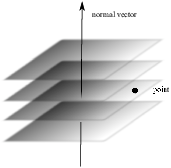
What is the equation of the plane which passes through the point ![]() and is perpendicular to the vector
and is perpendicular to the vector ![]() ? For a point
? For a point ![]() to be on the plane, the vector
to be on the plane, the vector ![]() must be perpendicular to
must be perpendicular to ![]() :
:
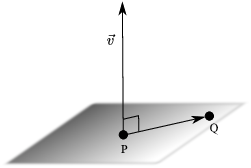
This means that the dot product of the vectors must be 0. Since ![]() , I have
, I have
![]()
Thus, the equation of the plane which passes through the point ![]() and is perpendicular to the vector
and is perpendicular to the vector ![]() is
is
![]()
Example. Find the equation of the plane which
passes through the point ![]() and is perpendicular to
the vector
and is perpendicular to
the vector ![]() .
.
![]()
Note: I got the second plane equation by multiplying out and simplifying the first. This isn't absolutely necessary, but it does make it easier to compare your answer to another one --- for example, in problems where you have a choice of more than one point.
Example. For the plane ![]() , find a normal vector to the plane and a
point on the plane.
, find a normal vector to the plane and a
point on the plane.
To find the normal vector, read off the coefficients of x, y, and z:
The normal vector is ![]() . (Of course, any multiple of
this vector would work.)
. (Of course, any multiple of
this vector would work.)
Since there are infinitely many points on the plane, you can't solve the plane equation for a unique point. Instead, you can:
(a) Set two of the variables equal to whatever numbers you want and solve for the third.
(b) "Juggle numbers" to find a combination that works.
As as example of (a), set ![]() and
and ![]() . I get
. I get ![]() , so
, so ![]() . The point
. The point ![]() lies on the plane.
lies on the plane.
Since it's better to avoid fractions if you're using the point in
subsequent computations, you might instead set ![]() and
and ![]() . This gives
. This gives ![]() , so
, so ![]() . Then
. Then ![]() is a point on the plane.
is a point on the plane.
As an example of (b), I just play with numbers --- preferably integers to avoid fractions --- till I find a combination that satisfies the equation. For example, I notice that
![]()
Therefore, ![]() is a point on the plane.
is a point on the plane.![]()
Example. Find the equation of the plane
containing the points ![]() ,
, ![]() , and
, and ![]() .
.
To construct a plane, you need a point on the plane and a vector
perpendicular to the plane. For the point on the plane, I can use any
of the three given points. I'll use ![]() .
.
When you need a vector perpendicular to something, a common approach
is to take the cross product of two vectors which lie in (or are
parallel to) the thing. In this case, I'll use the vectors ![]() and
and ![]() . Their cross product will be
perpendicular to the plane.
. Their cross product will be
perpendicular to the plane.
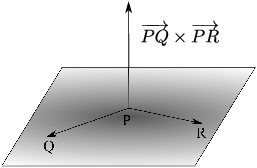
![]() and
and ![]() , so
, so

The plane is
![]()
Example. Determine whether the following planes are parallel:
![]()
Two planes are parallel if and only if their perpendicular vectors are parallel --- i.e. if and only if their perpendicular vectors are multiples.
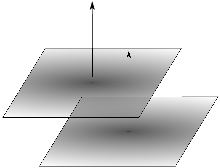
![]() is perpendicular to the first plane.
is perpendicular to the first plane. ![]() is perpendicular to the second plane. Since
is perpendicular to the second plane. Since ![]() , the two vectors are
parallel. Therefore, the planes are parallel.
, the two vectors are
parallel. Therefore, the planes are parallel.![]()
A line in space is determined by a point on the line and a vector parallel to the line.
The lines which are parallel to a given vector are like a stack of spaghetti noodles. Exactly one of the parallel noodles passes through a given point in space.
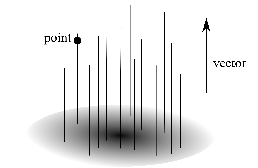
What is the equation of the line which passes through the point ![]() and is parallel to the vector
and is parallel to the vector ![]() ? For a point
? For a point ![]() to be on the line, the vector
to be on the line, the vector ![]() must be parallel to
must be parallel to ![]() :
:
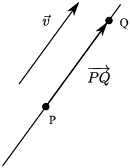
This means that ![]() and
and ![]() must be multiples. Since
must be multiples. Since ![]() , I have
, I have
![]()
Equating components, I find that the line which passes through the
point ![]() and is parallel to the vector
and is parallel to the vector ![]() has the parametric
equations
has the parametric
equations
![]()
Sometimes people use the symmetric equations instead. To get the symmetric equations from the parametric equations, solve the equations for t, then equate the results:
![]()
This assumes that ![]() ,
, ![]() , and
, and ![]() are nonzero. If any of them are 0,
use the parametric equations instead.
are nonzero. If any of them are 0,
use the parametric equations instead.
To go from the symmetric equations to the parametric equations, equate the three symmetric equation expressions to t, then solve for x, y, and z.
I'll usually use the parametric equations for a line in doing problems.
Example. For the following line, find a vector parallel to the line, and find two points which lie on the line.
![]()
Reading off the coefficients of the t's, I find that the vector ![]() is parallel to the line.
is parallel to the line.
To get points on the line, plug in specific values for t. For
example, ![]() gives the point
gives the point ![]() . And
. And ![]() gives the point
gives the point ![]() .
.![]()
Example. Find the parametric equations and the
symmetric equations of the line which passes through the points ![]() and
and ![]() .
.
I need a point on the line, and I have two. I'll use ![]() .
.
I need a vector parallel to the line. Since P and Q lie on the line,
the vector ![]() lies on the line:
lies on the line:
![]()
The parametric equations are
![]()
The symmetric equations are
![]()
For two different lines in space, there are several possibilities:
(a) The lines may intersect in a point. (If they intersect in more than one point, then they are the same line.)
(b) The lines may be parallel.
(c) The lines may be skew. (By definition, this means that they aren't parallel and don't intersect.)
A simple way to picture two skew lines is to imagine two non-parallel lines, one lying in the ceiling and the other in the floor:
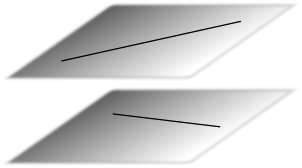
Example. Determine whether the following lines are parallel, skew, or intersect.
![]()
![]()
If they intersect, find the point where they intersect.
The first line is parallel to the vector ![]() . The second line is parallel to the vector
. The second line is parallel to the vector ![]() . The vectors aren't multiples, so the vectors aren't
parallel. Therefore, the lines aren't parallel.
. The vectors aren't multiples, so the vectors aren't
parallel. Therefore, the lines aren't parallel.
To determine where two things intersect, you solve their equations simultaneously.
Equate the two expressions for x:
![]()
Equate the two expressions for y and substitute ![]() :
:

Then ![]() .
.
That's not all! I must use the z-expressions as a consistency
check. Plug ![]() and
and ![]() into the z-equations:
into the z-equations:
![]()
The z-values do not agree. Therefore, the lines do not intersect.
Since they're not parallel and don't interest, they're skew.![]()
Notes: If the z-value had agreed, you could plug either s or t into the appropriate equations to find the intersection point. It is important to check the z-values for consistency.
Remarks. 1. A common mistake is to solve for s
and t as I did, but then to plug s or t in immediately to get a point
![]() --- mistakenly concluding that the lines
intersect. You must use all three sets of equations.
--- mistakenly concluding that the lines
intersect. You must use all three sets of equations.
2. Sometimes the lines in problems like this are given with the same parameter: i.e. both lines may use t, instead of t and s. In this situation, change the parameter in one of the lines so the lines have different parameter variables.
Example. Find the equation of the plane which
contains the point ![]() and the line
and the line
![]()
I need a point on the plane. I'll use ![]() .
.
I need a vector perpendicular to the plane. To construct a vector perpendicular to something, you often use the cross product. To use the cross product here, I need two vectors which lie in the plane.
Since the line lies in the plane, a vector parallel to the line may be regarded by translation as lying in the plane.
To get another vector, take a point Q on the line and construct the
vector ![]() .
.
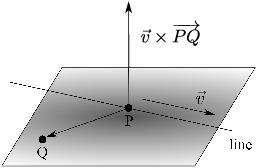
The vector ![]() is parallel to the line.
is parallel to the line.
I can get a point on the line by setting t equal to a number. Set
![]() ; I obtain
; I obtain ![]() . Then
. Then
![]()
Next, take the cross product of the two vectors:

This vector is perpendicular to the plane.
The equation of the plane is
![]()
Example. Determine whether the following plane and line are parallel:
![]()
![]()
If they aren't parallel, find the point at which they intersect.
A line and a plane are parallel if and only if the line's parallel vector is perpendicular to the plane's perpendicular vector --- i.e. if the line's parallel vector and the plane's perpendicular vector have dot product zero.
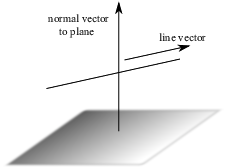
![]() is perpendicular to the plane.
is perpendicular to the plane. ![]() is parallel to the line.
is parallel to the line.
![]()
The vectors aren't perpendicular, so the line and plane aren't parallel.
To find the intersection point, plug the line equations into the plane equation:
![]()
Plug this back into the line equations. I get ![]() ,
, ![]() ,
, ![]() . The intersection point is
. The intersection point is ![]() .
.![]()
Example. The following lines are skew:
![]()
Find the equation of the plane which contains the first line and is parallel to the second line.
I need a point on the plane. The plane contains the first line, so I
can use a point on the first line. Set ![]() : I get
: I get ![]() .
.
I need a vector perpendicular to the plane. It's natural to take the
cross product of two vectors in the plane. For one vector, I use the
vector for the first line: ![]() .
Since the plane is parallel to the second line, I can regard the
second line's vector as lying in the plane, by translation. The
second line's vector is
.
Since the plane is parallel to the second line, I can regard the
second line's vector as lying in the plane, by translation. The
second line's vector is ![]() .
.
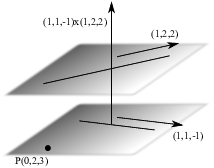
Take the cross product:

The plane is
![]()
Example. Find the equation of the line of intersection of the planes
![]()
There are many ways to do this problem.
Subtract twice the second equation from the first:

This gives ![]() .
.
Method 1. ( Parametric
equations) The equation ![]() gives
gives ![]() . Set
. Set ![]() , so
, so ![]() . Then
. Then

The line is
![]()
Method 2. Setting ![]() in
in ![]() gives
gives ![]() . Then plugging
. Then plugging ![]() and
and ![]() into
into ![]() gives
gives ![]() , so
, so ![]() . This means that
. This means that ![]() is a point on the line of intersection of the planes.
From here I can continue in a couple of ways.
is a point on the line of intersection of the planes.
From here I can continue in a couple of ways.
Method 2(a). Setting ![]() in
in ![]() gives
gives ![]() , so
, so ![]() . Then plugging
. Then plugging ![]() and
and ![]() into
into ![]() gives
gives ![]() , so
, so ![]() . This means that
. This means that ![]() is another point
on the line of intersection of the planes.
is another point
on the line of intersection of the planes.
The vector from ![]() to
to ![]() is
is ![]() . This vector is parallel to
the intersection line. Using the point
. This vector is parallel to
the intersection line. Using the point ![]() , I get the same line equations as I did earlier:
, I get the same line equations as I did earlier:
![]()
Method 2(b). The vector ![]() is perpendicular to the first plane. The vector
is perpendicular to the first plane. The vector ![]() is perpendicular to the second plane. Their cross
product is parallel to the line of intersection.
is perpendicular to the second plane. Their cross
product is parallel to the line of intersection.
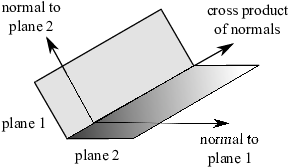
The cross product is

Using ![]() as the point on the line, I get the
equations
as the point on the line, I get the
equations
![]()
Example. (a) Show that the following lines intersect:
![]()
![]()
(b) Find the equation of the plane containing the two lines in part (a).
(a) Set the x-expressions equal:
![]()
Set the y-expressions equal:
![]()
Plug in ![]() :
:
![]()
Therefore, ![]() .
.
Check for consistency by substituting the s and t values into the equation for z:
![]()
Since the equation checks, the lines intersect. ![]() gives
gives ![]() ,
, ![]() ,
, ![]() : The intersection point is
: The intersection point is ![]() .
.![]()
(b) The vector ![]() is parallel to the first line, and
the vector
is parallel to the first line, and
the vector ![]() is parallel to the second line.
The cross product is perpendicular to the plane containing the lines:
is parallel to the second line.
The cross product is perpendicular to the plane containing the lines:

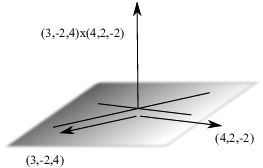
From part (a), the point ![]() is on both lines, so it
is surely in the plane. Therefore, the plane is
is on both lines, so it
is surely in the plane. Therefore, the plane is
![]()
Copyright 2018 by Bruce Ikenaga